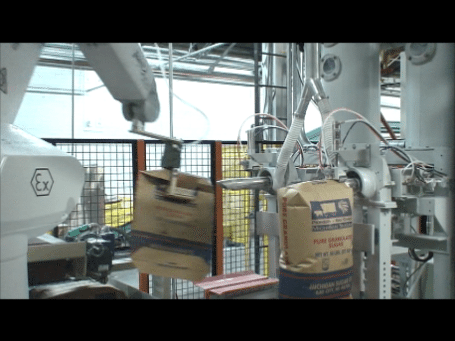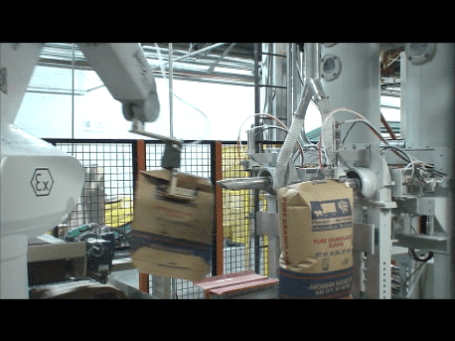A large producer of granulated sugar in Michigan was seeking a bag filling system to fill 50 lb and 100 lb valve bags at a rate of 600 bags per hour. To meet their customer and contract obligations, all of the sugar production for the entire year was required to be packaged over a 6 month period during the late fall and winter months of the year. The downtime was not only costly but lost production time might mean that they miss required delivery dates. The producer had been using antiquated belt-style valve bag fillers. The overriding problem with the existing machines was two-fold: One, the machines had a large number of mechanical moving parts that required continuous maintenance for which parts and support for the machines were limited and expensive. Two, the system was slowly filling with a maximum filling rate of 500 bags per hour. Not only was the old system not able to keep up with production requirements it was also becoming increasingly unreliable and susceptible to unexpected downtime and maintenance.
Although it was decided that an operator would continue to place empty bags on the filling machines in the new system, bag palletizing was conceived to be automated with a robotic bag palletizer. The new system would utilize one operator to place, fill and palletize 750 bags per hour on a continuous basis.
To achieve the client’s objectives, CBE designed a system with three (3) of its Model 730 Pressure Flow Air Packers integrated with an automatic robotic valve bag placer. The Model 730 had several distinct advantages for the application. First, each of the three (3) machines was capable of filling 6 bags per minute each (18 BPM total) on 50 Lb. bags which would easily meet the production requirement. Second, because the Model 730 uses a fluidizing air slide to convey the material and has no internal moving parts, no motors driving mechanical blades or flights shafts, maintenance was greatly reduced.

Bag filling was semi-automatic. Each filling sequence was initiated automatically by a sensor at the spout of the filling machine when the operator spouted a bag on the machine; no button push was required. Each bag would then fill to a pre-determined weight, selected by the operator, automatically. The filling machine had an integrated weighing scale, which worked in combination with a single PLC-based control package. The weighing controls were specially designed for valve bag filling applications and featured a gain-in-weight totalizing display. The controls were designed with the ability to communicate weight data to a printer or central management control system.
A pneumatic bag clamp sped up the placement and removal of the bags by eliminating the need for the operator to clamp and unclamp each bag from the filling spout at the beginning and end of each bag fill. The flow of material was automatically started and stopped by a multi-position pinch valve, called a pinch tube cutoff. The system controls signaled the pinch valve to reduce flow at a pre-programmed weight. The pinch valve would actuate to reduce product flow before closing at the end of each weigh cycle. This prevented overfilling of the product.
After the successful implementation of the first system, CBE was tasked with a follow-up project to increase the production capability of the system to a rate of 24 bags per minute to match the potential of the robotic bag palletizing system. Although the existing 3-spout Model 730 could not be expanded, CBE developed a system plan that would pair a new 2-spout Model 730 alongside the existing 3-spout system and use a custom bag merge system of specially designed bag index conveyors. The indexing system allowed the 3-spout system to run at its full normal speed and the 2-spout system to fill in available gaps in the conveying system to maximize the flow of filled bags delivered to the palletizing system. This system expansion was again highly successful and allowed our client to increase production by an additional 25% above the original system upgrade’s capability.


Recent Comments